“I love fishing. You put that line in the water and you don’t know what’s on the other end. Your imagination is under there.”
– Robert Altman, Director
My recent trip up to San Pedro got me thinking about the various fish that are available to eat here in Buenos Aires and surrounds. It is often asserted that no or few fish are eaten here, that there is nowhere to get a decent fish dish in town, etc. Not true. There are plenty of good places for fish and shellfish here. True, most of them are not “Argentine” restaurants, but some are – the majority are Asian, of all stripes, Spanish and Peruvian. But even amongst the local cuisine there are a good number that offer up interesting fish dishes. Now a few things are to my mind, mistakes. It is quite common to see a Roquefort sauce offered up atop a fish – all well and good if we’re talking a good, strong flavored fish, but too often it’s ladled over lenguado or mero, or something equally delicate in the whitefish world.
Over the next couple of months I’m going to be exploring some of the local classic fish dishes. I thought I’d start, however, by introducing you to the local fish. And, we’ll begin with the common freshwater fish of the Rio de la Plata and Paraná Delta. It is unfortunate that not more advantage is taken of these fish, because some of them are absolutely delicious. Most local spots, if they offer any freshwater fish it will be salmon or trout, from Chile or Bariloche, respectively, or Pejerrey, a fish we’ll get to momentarily. Only one spot in town specializes in the preparation of fish from the river, Jangada, which I recommend giving a try. All of these photos come from the fish stores near to my house, so they’re readily available, particularly during the summer.
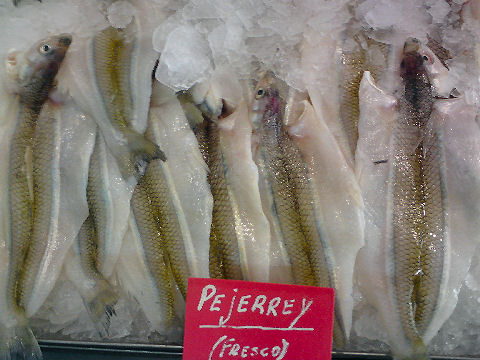
Since I just brought it up, let’s start with the Pejerrey, or South American Silverside family, Genus: Odontesthes, with several species, including platensis, bonariensis and others. The most common eating fish locally is probably the bonariensis, or Argentine Silverside. These are not big fish, in general – tending to be about 6-10 inches long, and very thin. The meat is gleaming white, with a silvery sheen or stripe on the outside. They have a fairly delicate flavor and are generally served up simply grilled or fried.
[Links to recipes as I blog them: a la Romana; con Salsa Rosada; Rellenos; a la Colonial; Ceviche; Cured; Papillote with Vegetables; “Pizza”]
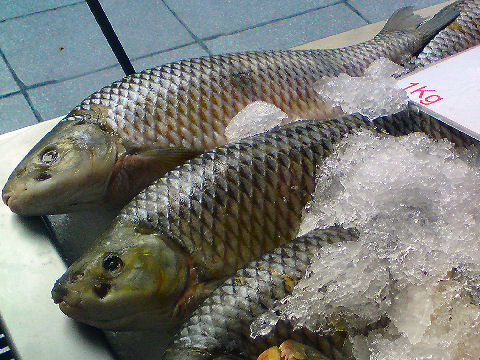
This is the Boga, or Leporinus obtusidens. sometimes also called piava or tres puntos. In Brazil, the piapara. It’s a greenish grey fish, generally weighing in around 2-3 kg (5-6 pounds), though there have been catches of boga that were as much as 8 kg (17.5 pounds). As an omnivore, it eats everything from grasses to crabs and snails, though its preferred food is cereal grains, and boga can often be found in abundance near places where cargo ships are loading or off-loading. I generally find that boga has a very strange, ammonia-like taste to it that isn’t overly pleasant – particularly when grilled.
[Links to recipes as I blog them: en pieles de panceta, risoto de papas y vegetales; vindaille/vindalay; caldo de peixe; pira]
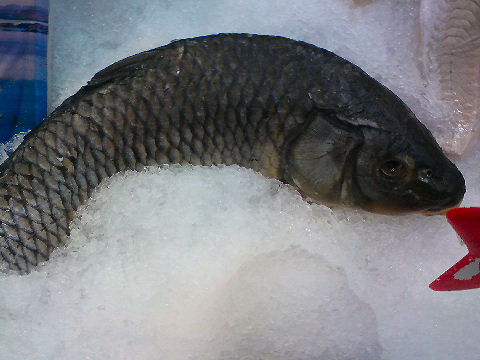
The Carpa, or common Carp, Cyprinus carpio. Based on what research I’ve done, I gather that the carpa is not native to these waters, but, as in many places, an invasive species. I rarely see them and was actually surprised to see one being offered in one of the fish markets. They’re omnivorous as well, eating primarily worms, crustaceans, insects and water plants. And, well, carp is carp – not a great eating fish, best used, as far as I’m concerned, ground up as part of making gefilte fish.
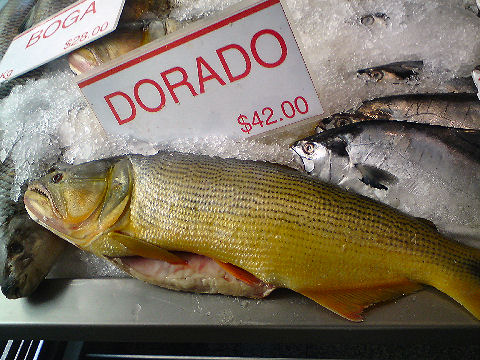
The Dorado, unrelated to the Mediterranean fish called dorade, which in English is a sea bream and in Spanish is besugo, a saltwater fish, this is the Golden Dorado, Salminus maxillosus or Salminus brasiliensis. They are powerful swimmers, with powerful jaws and sharp teeth. They range anywhere from 3-10 kg typically, though the largest on record weighed in at 31.4 kg (69 pounds). They are piscivores, eating primarily just other fish, their favorite being the sábalo. They have very fat rich meat and are great on the grill or fried. They’re often served up a la vasca, or Basque style, with a saute of tomatoes and bell peppers.
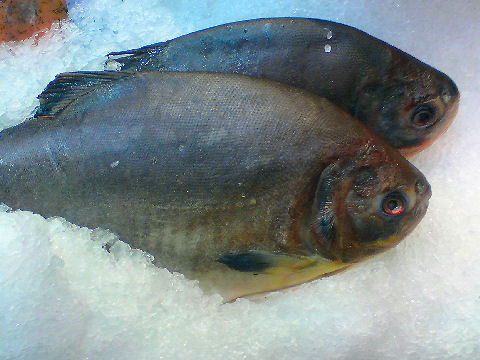
The Pacú is an omnivorous fish in the piranha family, and they look it, with though their teeth are slightly different – more squared off than the razorsharp ones of the piranha, and more of an overbite. There are several species in the family, though the most common in the delta here is the Piaractus mesopotamicus, also known as pez chato (“flat fish”), mbiraí, or piraí. These are fat rich fish, and again great for grilling. Most of the ones found here tend to be no more than about 2 kg in weight, though there are related species, like the giant pacú, which can grow to more than a meter in length and weigh in at 30+ kg.
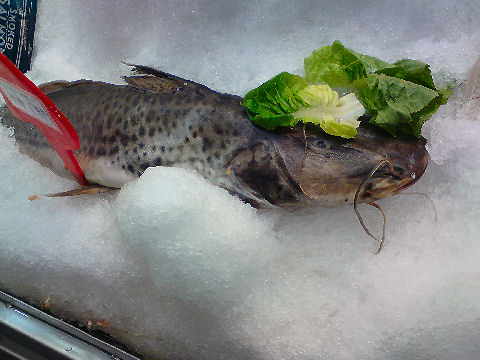
The Pati or Pez Gato is a long-whiskered freshwater catfish. They live in turbulent waters and so are well suited to the Rio de la Plata. Although omnivorous, they are primarily carnivorous, eating other fish and shellfish. They can easily grow to more than a meter in length. And, well, they taste like catfish – we’ll just have to introduce the locals to cornmeal crusts and a bit of hot sauce!
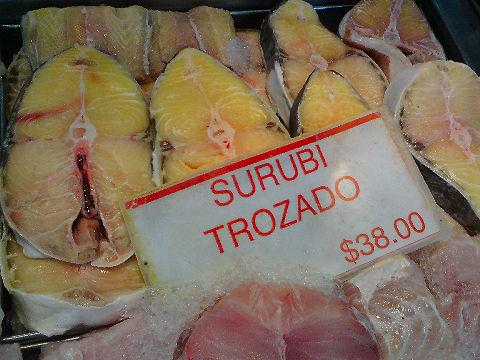
I could only find Surubí already cut up into steaks (“trozado”). In English known as the tiger shovelnose catfish, Brazilian tigerfish, or Tiger Sorubim, there are a trio of different species present in the delta, all belonging to the genus Pseudoplatystoma. The local name surubí is the native Guarani name for the fish, which is also known in various locales as doncella, zúngaro, moleque, pintado, bagre rayado, or pintadillo. They are piscivores, eating a wide variety of other fish, though, like the dorado above, they are particularly fond of sábalo. They are notable in the color of their flesh, which is a sort of peach orange-yellow, and are one of my favorites. (Various photos from others)
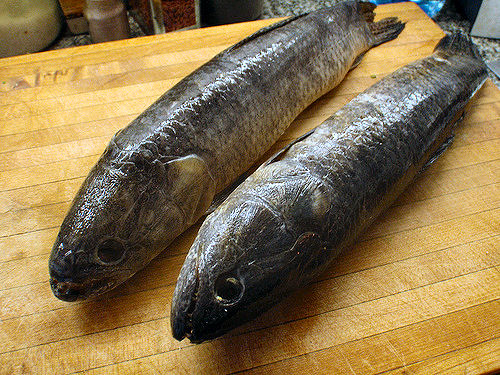
The Tararira or Trahira, is known as the wolf-fish or sometimes tiger-fish in English. It is a predatory fish, weighing in around 1-3 kg. It is an unusual fish as well, having some capacity for air-breathing, meaning it can propel itself on its fins across land from one pool of freshwater to another. It has a host of other common names, including Dientón or similar names in reference to its teeth, Bululu, Calabrote, Dormilón, Guabina, Guanchiche, Mocho, Moncholo, Perraloca, Perro, Rivolo, Tarango, Tarucha among them. I find it to be very bony, and difficult to work with, and other than encountering it a couple of years ago in a local fish market have never seen them here., though a quick internet search reveals several local recipes – which, if I can find the fish again, we’ll be giving a try.
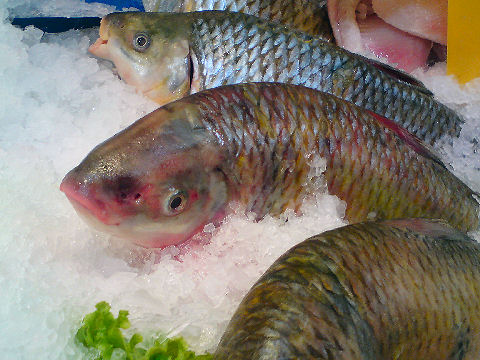
On to the poor Sábalo, the favorite food fish of many of the carnivorous fish of the river. These are a small member of the tarpon family, and go by the latin moniker Prochilodus lineatus. It is a mudsucker (and is also known as the chupabarro, literally mudsucker), inhabiting deep waters and sucking up organic mud, which it processes and filters to get to whatever flora and fauna are buried there for its feed. The fish is, as noted, pretty much the foundation of the food chain for larger piscivores, and with human fishing, it is a species that is rapidly in decline – which may be why I haven’t seen any recently in the fish markets. I know that there are fishing limits on it, and there have been temporary bans at different points in time. I haven’t tried one, so can’t tell you what it tastes like, though the whole mudsucking thing doesn’t bode well for flavor….
I caught two pejerrey today. First time catching any! Their skin and flesh is translucent, almost like gelatin (except for the organ area), until a short time after you remove them from the water. Then the flesh proceeds to slowly whiten. Next time I’ll take my camera just in case I get lucky again. Very cool to see how translucent they are.
We were armed for robalo so really, we lucked out on snagging a few with large hooks. There must have been a huge school judging by how fast our bait was consumed and a few gentlemen down the coast were catching some ever so often. Wish I could have caught a ton to make a feast but I’ll be happy fry these up with a little lemon and butter tonight as a snack.
Hi! I’m Fer from BA Cast. We loved this post and quoted it on our latest episode. If you want to check it out:
http://bacast.com/episode17-creation-to-go-cup-havanna-progress/
Saludos!
F.
Thanks for the plug!
Awesome article! A fishmarket here can be really confusing if not daunting for a foreigner, as fish names typically don’t translate well (and by the number of local common names you listed, some are nearly impossible to translate!).
I will keep this link as a reference, and since I’m a nutrition fanatic, I’ll definitely be passing it on to others. Can’t wait to hit Chinatown now! Thanks!
[…] up a nice little series of photos and step-by-steps for you. I’m going to start with the pejerrey, or South American silverside. Now, obviously one can prepare this, or probably any fish, […]
[…] 200th Paraguay! We start off with a couple of fish. You might remember these from my post on the freshwater fish of the Paraná delta (a post that’s taken on a life of its own as varied and sundry folk have linked to it and […]
[…] from the water – the pescado litoral, freshwater fish plate, a good number of fillets of pacú, our local member of the piranha family made their appearance lapped in a sweet and salty […]
[…] the blog – the post that’s garnered the most positive feedback, mostly by e-mail, my write-up of the available freshwater fish here in Buenos Aires. The most interesting to write, and explore, my recent dive into the history, […]
[…] back when I was thinking about getting together a guide to the local ocean fish to complement the posting on local freshwater fish. Might be time to get back to that […]
[…] going on two years since I wrote up my much referenced post on the local freshwater fish around here. At the time I had plans to continue on and cover the various ocean fish in the area as […]
Hi, I’m Ezequiel from Rosario Argentina.
I see the fishes’ pic and I should give you an advice. All that picture are from some mall or supermarket, to buy fresh fish you should go to the “Florida”. There are fishermen how sell fresh fish.
http://goo.gl/maps/KerVx <– Label B.
You could have a fresh fish if you know how to choose.
In my opinion Boga, Pacú and Dorado (is a bit dry for me) are the most delicious. Surubí and Patí are fatty.
And the last advice, if you are going to eat fish it should taste as fish, so prepare it grilled with salt and lemon. If you want try with blue cheese or "chimichurri" prepare it in other dish and try it individually
Ezequiel, thanks for your “advice”, which would certainly work for people living in Rosario, but since we don’t, it’s not really a workable suggestion. If Buenos Aires had a fisherman’s market, that’s where we’d go too, but it doesn’t. As to the type of fish, that all comes down to personal preference, no? For me, my favorite of those is the surubí. As to the cooking technique, well, again, preference, and here in Argentina those three methods seem to be about the only way fish gets prepared by most folk. Personally, I can’t stand blue cheese with fish, let alone that much of the blue cheese in this country is awful, and while chimichurri is fine, it’s just not that interesting – but that’s just my tastes, I’d rather prepare fish the way I learned elsewhere. (Though, there are several followup posts on this one with some local classic recipes that are different from those three methods, some of which I liked quite a bit, and none of which do I ever see on restaurant menus here.)
[…] don’t know what my fascination with pejerrey is (maybe because it’s a fish that’s so different from any that I used to encounter in […]
[…] haven’t forgotten my promise to keep providing fish recipes for the locally available fish. They’re coming, here and there. This week I tackled the Boga, a fish that I’ve used […]
[…] Heated that back up for service and added sauteed freshwater fish to it – a mix of trout and pejerrey (silverside), which were the only freshwater fish available in the market last week. Classically […]
[…] remix of an Amazonian soup, timbuche, this time with a mix of freshwater fish – trout, pejerrey, sábalo, surubí and patí. Next up, pasta, pictured above. Umbricelli with a mushroom and green olive cream sauce and […]
[…] a pleasant thing – come on, cold blood sausage? I was very curious to see how the sous vide surubí, or tigerfish, came out – fish is one of those difficult things to cook sous vide if […]
[…] panko coated dorado fishcake with coconut, coriander and honey sauces. A little sweet, but not over the top and we […]
[…] the fillets (it’s near impossible here to get filleted fish with skin, other than salmon and pejerrey – the latter of which will figure in below at one point). I was all set to just use a fresh […]
[…] the Andes in various forms. Beyond tripe, the most common versions are of chicken, beef, egg, and pejerrey (river fish). At its base, however, regardless of protein choice, the balance of the recipe remains […]
[…] (again, in place of habanero), garlic, salt, pepper, and cumin, and fish steaks, in this case, surubí, or tigerfish. Using a freshwater fish probably isn’t traditional, but it is a firm fleshed, […]
[…] then, being able to find freshwater fish here on a menu has become less and less common. I mean, there are a few steakhouses around that offer […]
[…] Ceviche – Brazilian tigerfish (here called surubí, a freshwater fish), cured in lime juice, fish sauce, ginger, salt and pepper. Mixed with red […]